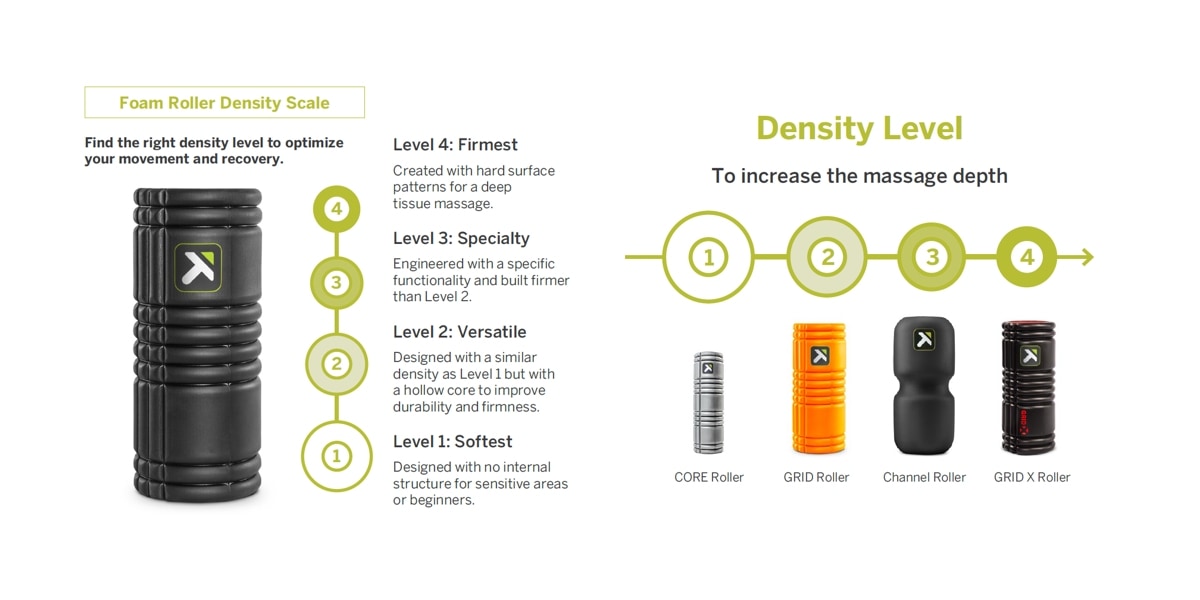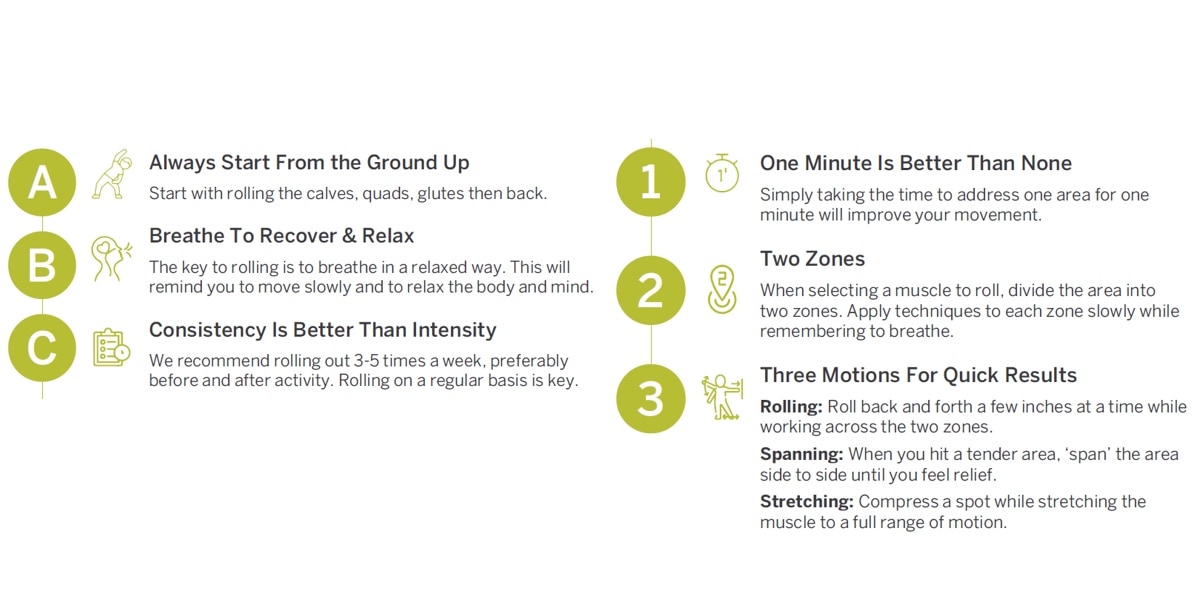You've just crushed a workout, but now your muscles are a little (ahem) cranky. Instead of laying horizontal waiting for tomorrow's DOMS (delayed onset muscle soreness) to kick in, there's a much better way to tackle it.
Enter foam rolling—the quirky, foam-covered saviour of your post-workout routine. It might look like a simple tool, but trust us, it packs some serious muscle-relieving magic inside and it's worth the time. Not only do foam rollers help tight muscles, but they're said to boost circulation, flexibility, and recovery, making muscle recovery that little bit easier.
So, if you're ready to ditch the stiffness and show your muscles some TLC, foam rolling is here to make your fitness life a whole lot more comfortable. To find out more, we caught up with Physical Therapist Daniel Lawrence from TriggerPoint to find out everything we need to know about foam rolling. First, let's start with the basics.
What is Foam Rolling?
"Foam rolling is a form of self-myofascial release and is often described as an affordable self-massage involving the application of bodyweight pressure across a cylindrical object to manipulate tissue states," says Daniel.
"To break it down, all the muscles in the body are connected by fascia. Fascia can become unhealthy due to overuse, injury or repetitive movements. Foam rolling aims to keep fascia healthy by circulating fresh, oxygenated blood through it."
"When compression is added to a muscle, it can help stimulate nerve receptors, initiating change in the nervous system, leading to an overall reduction of tension and muscle tightness", says Daniel who regularly teaches on the topic for TriggerPoint.
"When the compression begins, blood meant for that area is obstructed, and then when the pressure is removed, nutrient rich blood will flow to the area to promote the healing process. Just imagine squeezing and releasing a sponge"
What are the Benefits of Foam Rolling?
There's a solid amount of research supporting the benefits of self-myofascial release¹ (aka foam rolling), showing that it can have a positive impact on everything from increasing flexibility to speeding up recovery.
By applying pressure to specific areas of muscle tension, foam rolling helps release tight spots and improve blood flow, which can make a big difference in how quickly your muscles bounce back after a workout. So, it's not just about feeling good in the moment—it's a recovery strategy to keep you performing at your best. Some of the said benefits include ²:
- Delayed onset of fatigue
- Enhanced flexibility
- Increases range of motion
- Recovery benefits by reducing the negative effects of delayed onset muscle soreness (DOMS)
- Increase blood flow and circulation
- Improve balance
- Improve posture
- Natural pain relief
So, How Do You Choose a Foam Roller?
Choosing the right foam roller really depends on your personal needs and comfort level as ultimately the type of foam roller will impact the level of massage you receive, explains Daniel who regularly uses TriggerPoint rollers in his own routine.
"For example, a less dense roller will conform more around the body, compared to a highly dense foam roller which offers no conformity. The less dense rollers will work closer to the surface, whereas a dense roller will work deeper tissues."
If you're new to foam rolling, it might be a good idea to start with a softer, more forgiving roller to avoid too much discomfort. As you get used to the sensation, you can move to a firmer roller for a deeper massage if you wish.
For those dealing with intense muscle knots, you may want to up the ante with a roller with deeper ridges or bumps to help provide extra pressure and target stubborn areas more effectively.
If you're looking for something portable, a smaller, travel-sized foam roller can be a great option. Ultimately, the best roller is the one that feels comfortable and effective for your body.
Density and Firmness Options
When selecting a foam roller, density and firmness are crucial factors to consider. Foam rollers typically come in three density levels and varying lengths:
- Soft (gentle pressure) – beginners or sensitive areas
- Medium (moderate pressure) – intermediate users, general use
- Firm (intense pressure) – experienced users, deep tissue work
Choose a density that matches your experience level and specific needs. Beginners may want to start with a softer roller and gradually progress to firmer options as they become more comfortable with the technique.
Size and Portability Considerations
Foam rollers come in various sizes, each with its own advantages:
- Full-size (approx. 60-90cm): Ideal for home use, offers versatility for full-body rolling
- Half-size (approx. 33cm): Great for travel, fits easily in gym bags
- Nano or mini rollers (approx. 19cm): Perfect for targeting specific areas or on-the-go use
Consider your space limitations and intended use when choosing the size. If you plan to travel frequently with your roller, you may want to opt for a more portable option.
Textured Vs. Smooth Rollers
Foam rollers can have either a smooth or textured surface:
- Smooth rollers: Provide even pressure, ideal for general use and beginners
- Textured rollers: Feature bumps or ridges for deeper tissue manipulation
Textured rollers can be more effective for targeting knots and trigger points but may be too intense for some users. Consider your pain tolerance and specific needs when deciding between smooth and textured options.

When Rolling, Remember ABC123

How Do You Foam Roll?
Using a foam roller is pretty straightforward, but there are a few key things to keep in mind to get the most out of it and avoid any discomfort. Start by targeting a large muscle group, like your quads, hamstrings, or back. Place the roller under the muscle and slowly roll up and down, and side to side, using your body weight to control the pressure.
As you roll, pay attention to any tight or uncomfortable spots—when you find one, pause for a couple of seconds to really work it out. But remember, don't linger too long in one spot; a brief pause is enough (try 30 seconds), or you risk bruising yourself—ouch.
While it's normal for foam rolling to feel uncomfortable, especially when you're targeting a tight spot, it should never feel like actual pain—if the discomfort becomes too intense, shift your weight to ease up on the pressure.
Most importantly, listen to your body—if something feels wrong, back off. Be mindful of where you roll: avoid joints or bony areas, as foam rolling there won't help and could cause unnecessary strain. Never foam roll your lower back, as direct pressure on the lumbar spine can lead to muscle spasms and discomfort. Keep the focus on your muscles, and you'll be good to go!
Can You Ever Foam Roll Too Much?
Well, according to experts, it's not so much about rolling too much, but more about rolling too hard. While foam rolling is generally safe and beneficial when done properly, using excessive pressure can lead to bruising or discomfort. The key is to listen to your body—if the pressure starts to feel unbearable, it's time to ease off. Also make sure you stretch between rolling.
"The key component is to identify discomfort vs. pain when foam rolling," says Daniel. "You should be feeling a maximum of only mild discomfort when foam rolling; if you experience pain, stop and adjust the placement of the roller. If the pain is not relieved with readjustment, stop and seek further advice from a professional."
Over rolling can lead to issues such as:
- Bruising
- Soreness or discomfort
- Inflammation
How Often Should You Foam Roll to See Benefits?
TriggerPoint recommends the optimal frequency for foam rolling is generally three to five times a week, with sessions ideally occurring both before and after physical activity.
To ensure effectiveness, each muscle group should be massaged for about 30 to 60 seconds, allowing enough time to target the muscles properly and achieve the desired benefits of increased flexibility and reduced soreness.
Should You Foam Roll?
Foam rolling can be a beneficial addition to your fitness or everyday routine, particularly for enhancing muscle recovery, improving flexibility, and potentially boosting fitness or workout performance. While results may vary from person to person, research suggests that foam rolling, when done correctly, can help reduce muscle soreness and improve overall mobility—making it a great tool, especially for those with a 9-to-5 desk job that need to stretch it out.
However, it's essential to remember that it should be used as part of a balanced approach to exercise, alongside proper warm-ups, stretching, and recovery techniques. If you're considering foam rolling, always listen to your body and start with gentle pressure to avoid injury, gradually increasing intensity as needed. If something doesn't feel right, if the pain is too intense, or if you're injured, it's important to seek medical advice before continuing.
Ultimately, whether foam rolling is right for you depends on your personal goals and needs, but for many, it offers a simple, effective way to support recovery and enhance movement.
Ready to Shop?
Check out our entire range of foam rollers or head in-store to speak to one of our friendly rebel staff to help find the right one for you.
The content provided on this blog is for informational purposes only and should not be considered as medical advice. Always consult with a qualified healthcare professional before making any decisions regarding your health, especially if you are injured, have concerns, or are considering changes to your health routine.
References
- Wiewelhove, T., Döweling, A., Schneider, C., Hottenrott, L., Meyer, T., Kellmann, M., Pfeiffer, M., & Ferrauti, A. (2019). A meta-analysis of the effects of foam rolling on performance and recovery. Frontiers in Physiology, 10, 376. https://doi.org/10.3389/fphys.2019.00376
- Beardsley, C., & Škarabot, J. (2015). Effects of self-myofascial release: A systematic review. Journal of Bodywork and Movement Therapies, 19(4), 747–758. https://doi.org/10.1016/j.jbmt.2015.01.003
 Activity Tracker
(3)
Activity Tracker
(3)
 collabcollection
(1)
collabcollection
(1)
 cycling
(1)
cycling
(1)
 elliecarpenter
(1)
elliecarpenter
(1)
 fitness equipment, home gym equipment, cardio equipment
(1)
fitness equipment, home gym equipment, cardio equipment
(1)
 garminfenix7pro
(1)
garminfenix7pro
(1)
 garminfitnesswatches
(1)
garminfitnesswatches
(1)
 garminsmartwatches
(1)
garminsmartwatches
(1)
 garminsportsmartwatches
(1)
garminsportsmartwatches
(1)
 healthandwellbeing
(1)
healthandwellbeing
(1)
 lifeline
(1)
lifeline
(1)
 loneliness
(1)
loneliness
(1)
 mentalhealth
(1)
mentalhealth
(1)
 mulga
(1)
mulga
(1)
 nextleveltraining
(1)
nextleveltraining
(1)
 Nike leggings guide
(1)
Nike leggings guide
(1)
 Nike tights guide
(1)
Nike tights guide
(1)
 outdoorworkouts
(1)
outdoorworkouts
(1)
 running
(1)
running
(1)
 smartsmartwatches
(1)
smartsmartwatches
(1)
 Smartwatch
(3)
Smartwatch
(3)
 smartwatches
(1)
smartwatches
(1)
 sport
(1)
sport
(1)
 Sports Bra
(1)
Sports Bra
(1)
 spring
(1)
spring
(1)
 springessentials
(1)
springessentials
(1)
 springfitness
(1)
springfitness
(1)
 springingintofitness
(1)
springingintofitness
(1)
 strongertogether
(1)
strongertogether
(1)
 suicideprevention
(1)
suicideprevention
(1)
 swimming
(1)
swimming
(1)
 teamsport
(1)
teamsport
(1)
 training
(1)
training
(1)
 worldhealthmonth
(1)
worldhealthmonth
(1)

